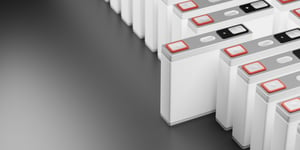In the United States, there was over $128 billion in announced investments in EV battery factories and EV battery recycling during 2022.
As the electric vehicle market expands, the focus on EV battery manufacturing has shifted to safety-proofing the internal components while optimizing the strength and weight of all parts.
Even the best battery pack design will only succeed with strong connective pieces. Having worked with thousands of different materials, Strouse knows that the success of your part depends on the suitability of your adhesive connections.
Knowing which materials are effective when designing an EV battery seal will help save time by narrowing down your options and giving you a better idea of what materials manufacturers actually use in the EV industry.
Why is it Crucial to Seal EV Batteries?
Sealing the outer casing of the internal components within the EV battery as well as the battery itself is essential to guard its inner mechanisms against particles, moisture, and electromagnetic or radio interference.
Not only must manufacturers seal EV batteries to keep exterior contaminants from causing a rupture, but the batteries themselves can also cause major harm due to their internal components. EV batteries are powerful mechanisms, but when their structural integrity is disrupted, they become flammable hazards leaking fluids.
Placing a strong seal on electric car batteries reduces the odds of a thermal runaway catastrophe resulting from a malfunction where the heat escapes one battery cell, flooding another until there’s a chain reaction that can result in a worst-case overheating scenario.
What Sealing Materials Are Used in EV Batteries?
Within the rapidly growing market of electric vehicles, every company with skin in the game is working to find the best combination of design and materials.
Having worked with some of the more major electric vehicle manufacturers in the past, several types of sealing materials have stood out to us as being reliable for EV batteries: double sided lse tapes and acrylic foam tapes.
We will discuss why each of these tape categories is optimal for EV battery sealing based on its adhesive abilities and the ultimate goal of your design.
DOUBLE SIDED LSE TAPES
LSE (Low Surface Energy) tapes can adhere to surfaces that otherwise would be challenging to stick to.
Many surfaces have a low surface energy, meaning it’s more difficult to bond them. For instance, metals are often left with oily residue from coatings intended to prevent rust and other types of corrosion. These coatings make it harder for the adhesive to stick, at which point you could either treat the surface by adding texture or use another adhesive material, like double sided LSE, for bonding.
Since the internal components of your EV battery could be covered in different coatings, you’ll want to do tests using different LSE sealing materials to ensure there won’t be any failures later on.
ACRYLIC FOAM TAPES
Similar to any internal combustion engine, EV batteries reach significant temperatures, up to 158-212 degrees F (70-100 degrees C), at which point there’s a higher risk of thermal runaway.
Acrylic foam tapes are commonly used in the automotive industry because of their durability and ability to survive very high temperatures. These properties also make them ideal for holding together connections within EV batteries.
Rather than using mechanical fasteners (like screws and bolts) or liquid adhesive, attaching parts with acrylic foam tape is a quick, simple, and clean process that leaves little room for error, especially if you’re using pre-cut tape or looking for gasket material.
Acrylic foam tapes are lightweight yet strong fasteners, making them an ideal choice for assembling EV battery packs where each new component must be attached.
How Can I Choose EV Battery Sealing Materials?
The material you choose to seal an EV battery will depend on the battery’s location, size, composition, and design.
What are the goals for your EV battery seal? Are you focusing on durability and heat resistance to achieve a long life cycle, or do you factor in abilities like EMI shielding or building a gasket against moisture? Or, do you need all of the above?
Are you looking for general EV battery adhesives? You can check out some of the internal bonding solutions and decide whether it makes sense for you to pursue them.
If you know what you’re hoping to get out of your design, you’re probably at the point of seeking out the right material for your prototype or manufacturing stage. For a prototype, try our Sample Express process with your design. Otherwise, feel free to check out our Learning Center to answer any further questions you might have.






